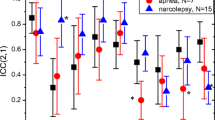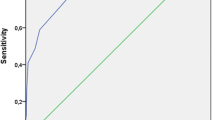Abstract
Objective
To estimate the interobserver reliability (IR) of the minimal diagnostic criteria for the parasomnias provided in the International Classification of Sleep Disorders Revised (ICSD–R).
Methods
Fifty consecutive subjects underwent a structured interview by three doctors based on the ICSD–R minimal criteria for the diagnosis of 13 parasomnias at any time in life. IR was calculated by Kappa statistics and interpreted according to conventional categories.
Results
In the group of Arousal Disorders, IR was “substantial” (kappa 0.74) for confusional arousals, “slight” (kappa 0.36) for sleepwalking, “fair” (kappa –0.02) for sleep terrors. In the group of Wake–Sleep Transition Disorders, IR was “substantial” to “almost perfect”, but “moderate” for sleep starts (kappa 0.41). In the group of Parasomnias usually associated with REM Sleep, IR was “substantial” (kappa 0.69) for sleep paralysis, “moderate” (kappa 0.46) for RBD, “fair” (kappa 0.25) for nightmares. In the group of Other Parasomnias, IR was “substantial” to ”almost perfect” (kappa between 0.73 and 0.93).
Conclusions
When the clinical diagnosis of parasomnias is based on the ICSD–R: 1) the majority of Arousal Disorders and REM sleep parasomnias showed only a “fair” to “moderate” IR; 2) all of the other parasomnias showed a ”substantial” to “almost perfect” IR. Nosological entities with unsatisfactory IR share complex motor phenomenology associated with a mental state difficult for the patient to define. The source of disagreement probably lies in the difficulty in interpreting patients’ reports. For these parasomnias IR must be verified and possibly improved with training.
Similar content being viewed by others
References
American Academy of Sleep Medicine (2001) International Classification of Sleep Disorders, revised: Diagnostic and Coding Manual. Rochester, Minnesota: American Academy of Sleep Medicine
Partinen M, Hublin C (2000) Epidemiology of Sleep Disorders. In: Kryger MH, Roth T, Dement WC (eds) Principles and Practice of Sleep Medicine. Philadelphia: WB Saunders Company
Montagna P (1992) Nocturnal paroxysmal dystonia and nocturnal wandering. [Review]. Neurology 42(7 Suppl 6):61–67
Scheffer IE, Bhatia KP, Lopes-Cendes I, Fish DR, Marsden CD, Andermann F, Andermann E, Desbiens R, Cendes F, Manson JI, Berkovic SF (1994) Autosomal dominant frontal epilepsy misdiagnosed as sleep disorder. Lancet 343(8896):515–517
Scheffer IE, Bhatia KP, Lopes-Cendes I, Fish DR, Marsden CD, Andermann E, Andermann F, Desbiens R, Keene D, Cendes F, Manson JI, Constantinou JEC, McIntosh A, Berkovic SF (1995) Autosomal dominant nocturnal frontal lobe epilepsy. A distinctive clinical disorder. Brain 118:61–73
Plazzi G, Tinuper P, Montagna P, Provini F, Lugaresi E (1995) Epileptic nocturnal wanderings. Sleep 18:749–756
Plazzi G, Montagna P, Provini F, Tinuper P, Lugaresi E (1998) Sudden arousals from slow-wave sleep and panic disorder. Sleep 21:548
Oldani A, Zucconi M, Asselta R, Modugno M, Bonati MT, Dalpra L, Malcovati M, Tenchini ML, Smirne S, Ferini- Strambi L (1998) Autosomal dominant nocturnal frontal lobe epilepsy. A video-polysomnographic and genetic appraisal of 40 patients and delineation of the epileptic syndrome. Brain 121:205–223
Provini F, Plazzi G, Tinuper P, Vandi S, Lugaresi E, Montagna P (1999) Nocturnal frontal lobe epilepsy. A clinical and polygraphic overview of 100 consecutive cases. Brain 122:1017–1031
Longstreth WT, Koepsell TD, van Belle G (1987) Clinical neuroepidemiology: 1. Diagnosis. Arch Neurol 44:1091–1099
Buysse D, Young T, Edinger J, Carroll J, Kotagal S (2003) Clinicians’ use of the International Classification of Sleep Disorders (ICSD): results of a national survey. Sleep 1:48–51
Vignatelli L, Plazzi G, Bassein L, Barbato A, De Vincentiis A, Lugaresi E, D’Alessandro R (2002) on behalf of the “GIN-SEN”.“ICSD Diagnostic Criteria for Narcolepsy: Interobserver Reliability”. Sleep 25:193–196
Bologna, Genova, Parma and Pisa (2003) Universities group for the study of REM Sleep Behaviour Disorder (RBD) in Parkinson’s Disease. “Interobserver reliability of ICSD-R criteria for REM sleep behaviour disorder”. J Sleep Res 12(3):255–257
Fleiss JL (1981) Statistical methods for rates and proportions. 2nd ed. New York: John Wiley, pp 212–236
Landis JR, Koch GG (1977) Measurement of observer agreement for categorical data. Biometrics 33:159–174
Lipton RB, Stewart WF, Merikangas KR (1993) Reliability in headache diagnosis. Cephalalgia 13(Suppl 12):29–33
Schramm E, Hohagen F, Grasshoff U, Riemann D, Hajak G, Weeb HG, Berger M (1993) Test-retest reliability and validity of the structured interview for sleep disorders according to DSM-IIIR. Am J Psychiatry 150:867–872
Author information
Authors and Affiliations
Corresponding author
Rights and permissions
About this article
Cite this article
Vignatelli, L., Bisulli, F., Zaniboni, A. et al. Interobserver reliability of ICSD–R minimal diagnostic criteria for the parasomnias. J Neurol 252, 712–717 (2005). https://doi.org/10.1007/s00415-005-0723-1
Received:
Revised:
Published:
Issue Date:
DOI: https://doi.org/10.1007/s00415-005-0723-1




